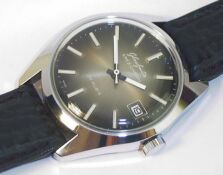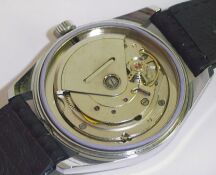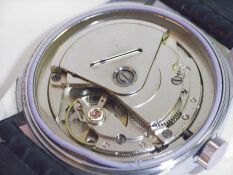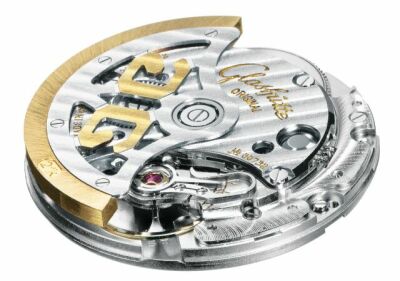If one compares the pictures of Glashuette Original movements in older catalogues with those printed in the recent ones, the different movement designations are immediately evident: The older watches are equipped with the movement cal. 10-30, whereas the newer ones have the cal. 39. However, aside from the drastically improved optical finish, the two movements seem to be the same: the same wheels and the same screws seem to be located in the same places on both movements. So where are the differences that justify that new designation, or is this just a try to cheat, to pretend a new movement where there is none?
Let’s have a look at the history of these two movements: When the communist German Democratic Republic found its end as a souvereign state, the state-owned “Glashuetter Uhrenbetrieb” was busy developing a new selfwinding movement. Solid it should be, and efficient.
Before the works could be finished, the company was sold to the French movement manufacturer France Ebauches SA. This company tried to save itself from bankruptcy by means of German know-how and the cheap labour in Eastern Germany.
The new selfwinding movement should compete with the Swiss movements produced by ETA, and was therefore developed specifically with a high momentum and maximum universality in mind.
Before the short-time owner of the Glashuette watch manufactory had to develop a new movement, they found already a good movement in Glashuette: In 1978, the V.E.B. ("Volkseigener Betrieb" = People's owned company)
Glashuetter Uhrenbetriebe (GUB) brought out their last completely new construction, the cal. 11-26, dubbed
Spezichron.
This Spezichron was modernized in several steps under control of first the France
Ebauches, then the Treuhand-Anstalt, and finally of Heinz W. Pfeifer, until it found its way as cal. 10-30 into the new watches of Glashuette Original. Under control of the
Treuhandanstalt, which, from 1990 to 1994, took over the former East German state-owned companies and sought to bring them into the private sector, the movement cal. 10-30 was completed and used in a new and very cheap line of watches after 1993.



Spezichron and cal. 11-27 photos courtesy of Herbfarm
This movement was the successor of the popular "Spezimatic", which was produced from 1964 until 1980.
Compared to the Spezimatic, the new Spezichron was smaller and faster: 28,800 A/h, while the Spezimatic only had 18,000. With that movement, the East German GUB could compete with the common movements of Swiss origins. The Spezichron was solid and accurate. Additionally, a version with weekday display was made; it was designated cal. 11-27.
 A year later, in 1994, the company was bought by Heinz W. Pfeifer, and immediately the cal. 10-30 was thoroughly revised in order to equip high-class watches. More than 60 changes were made, until the movement, which internally was designated cal. 10-30/2, was used for the then new “Klassik”-line. However, the movement’s potential for refinement was exhausted. It was used in all self-winding Glashuette Original watches, including the chronographs, which added a chrono module to the base movement.
A year later, in 1994, the company was bought by Heinz W. Pfeifer, and immediately the cal. 10-30 was thoroughly revised in order to equip high-class watches. More than 60 changes were made, until the movement, which internally was designated cal. 10-30/2, was used for the then new “Klassik”-line. However, the movement’s potential for refinement was exhausted. It was used in all self-winding Glashuette Original watches, including the chronographs, which added a chrono module to the base movement.
Yet there were plans for more complications, which could not be based on the trusted 10-30 movement; a new development was necessary. However, it was neither economically feasible nor desirable to have completely new cases and dials produced for the new base movement. Therefore, the starting point of the effort was the condition, that the new movement had the same dimensions, as well as the location of important parts, such as the winding stem, must be the same as in the old 10-30. Additionally, the planned new complication modules should have enough space on the movement’s front.
All elements of the 10-30 movement, which were tried and reliable, were taken over into the new construction, above all the complete escapement was transferred. Even these parts were refined, however, with the addition of a swan neck adjustement, for example.
 The result of the development was the new cal. 39 movement, which from the outside, looked like the old 10-30. Yet of the originally 130 parts, only 17 remained unchanged. The new movement had more jewels, a better adjustment, and, above all, a better ability to wear additional complication modules.
The result of the development was the new cal. 39 movement, which from the outside, looked like the old 10-30. Yet of the originally 130 parts, only 17 remained unchanged. The new movement had more jewels, a better adjustment, and, above all, a better ability to wear additional complication modules.
With the 10-30, every module had to be autonomous; that means, that each module had to consist of an upper an a lower baseplate, so that the final movement had four plate layers. The new cal. 39 movement was constructed in a way that its upper baseplate could serve as the lower base of the module, resulting in a “sandwich” of only three plate layers. This saves space which can be used for more complicated modules.
Finally, the optical qualities of the new movement were drastically improved: skeletonized rotor, finely grinded wheels, angled plates and teeth, the decoration work entirely done by hand. In spite of the still solid base of a movement designed to compete with the ETA-workhorses, the Glashuette Original cal. 39 without doubt is one of the finest selfwinding movements on the market.
The cal. 26 movement found in the watches of UNION/Glashuette, is based on that cal. 39 movement, but is changed in two essential ways: It consists of 12 parts less than its GO counterpart (mainly in the fine adjustement area), and its decoration is mostly machine-made. This saves a lot of money and enables UNION, to offer fine inhouse movements in well-made, competitively priced watches.
The Glashutte Original Forum | ThePuristS.com Home Page
Email Us | Sign Guestbook.
Copyright January 2002 - Dr. Marcus Hanke and ThePuristS.com - all rights reserved